

Compact Muon Solenoid
LHC, CERN
| CMS-PAS-EXO-24-007 | ||
| Search for low mass vector and scalar resonances decaying into quark-antiquark pairs | ||
| CMS Collaboration | ||
| 19 July 2024 | ||
| Abstract: A search for low mass resonances decaying into quark-antiquark pairs is presented. The analysis uses proton-proton collision data at $ \sqrt{s}= $ 13 TeV collected by the CMS detector at the CERN LHC, corresponding to an integrated luminosity of 138 fb$ ^{-1} $. The search targets resonances with masses from 50 to 300 GeV, produced in association with large initial-state radiation. Two coupling scenarios are considered, with the resonances coupling either equally to all flavors of quark or preferentially to bottom quarks. The resonances are reconstructed as large-radius jets with two-pronged substructure and are identified using the ParticleNet algorithm. Separate signal regions are defined to target resonances decaying to light- or heavy-flavor quarks. The invariant jet mass spectrum is scrutinized for narrow excesses over a smoothly falling background. No evidence for such resonances is observed, and limits are set on the couplings of new scalar and vector resonances to quarks. For dijet resonances with masses from 50-300 GeV, these are the most sensitive limits to date. | ||
| Links: CDS record (PDF) ; Physics Briefing ; CADI line (restricted) ; | ||
| Figures | |
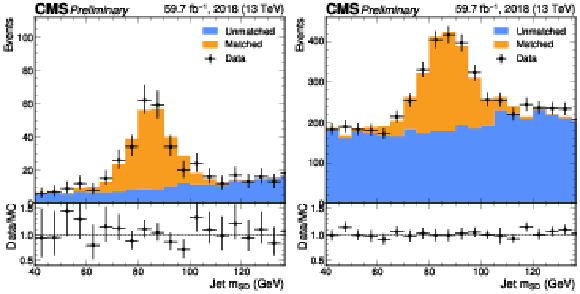
png pdf |
Figure 1:
Representative $ m_{\rm SD} $ distributions for the $ \mathrm{W}(\mathrm{q}\overline{\mathrm{q}}') $ control region, for events passing (left) and failing (right) the $ p_{\textrm{2-prong}} $ requirement. The data and fitted templates are shown for the 2018 data-taking period. The matched component (orange) corresponds to jets matched to boosted W bosons from $ \mathrm{t}\overline{\mathrm{t}} $ events, while the unmatched component (blue) comprises nonresonant backgrounds. |
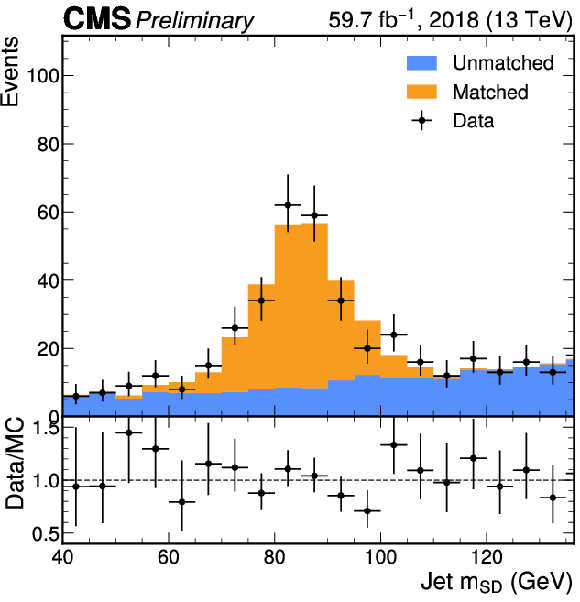
png pdf |
Figure 1-a:
Representative $ m_{\rm SD} $ distributions for the $ \mathrm{W}(\mathrm{q}\overline{\mathrm{q}}') $ control region, for events passing (left) and failing (right) the $ p_{\textrm{2-prong}} $ requirement. The data and fitted templates are shown for the 2018 data-taking period. The matched component (orange) corresponds to jets matched to boosted W bosons from $ \mathrm{t}\overline{\mathrm{t}} $ events, while the unmatched component (blue) comprises nonresonant backgrounds. |
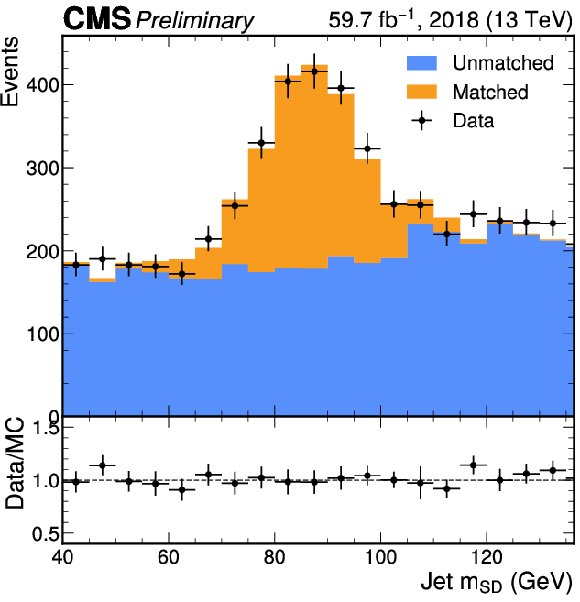
png pdf |
Figure 1-b:
Representative $ m_{\rm SD} $ distributions for the $ \mathrm{W}(\mathrm{q}\overline{\mathrm{q}}') $ control region, for events passing (left) and failing (right) the $ p_{\textrm{2-prong}} $ requirement. The data and fitted templates are shown for the 2018 data-taking period. The matched component (orange) corresponds to jets matched to boosted W bosons from $ \mathrm{t}\overline{\mathrm{t}} $ events, while the unmatched component (blue) comprises nonresonant backgrounds. |

png pdf |
Figure 2:
The jet $ m_{\rm SD} $ distributions in the high-$ p_{\textrm{bvl}} $ (left) and low-$ p_{\textrm{bvl}} $ (right) signal regions, fitted with a signal-plus-background hypothesis corresponding to a Z' boson with a mass of $ m(\mathrm{Z}')= $ 220 GeV. The distributions are summed across all five $ p_{\mathrm{T}} $ bins and the four data-taking periods. The dashed lines represent the expected Z' signal yields for $ g_{\mathrm{q}}= $ 0.25 multiplied by a factor of two for visibility, while the fitted signal itself is shown as a hatched area. The lower panel shows the residual difference between the data and the overall background, divided by the statistical uncertainty in the data. |
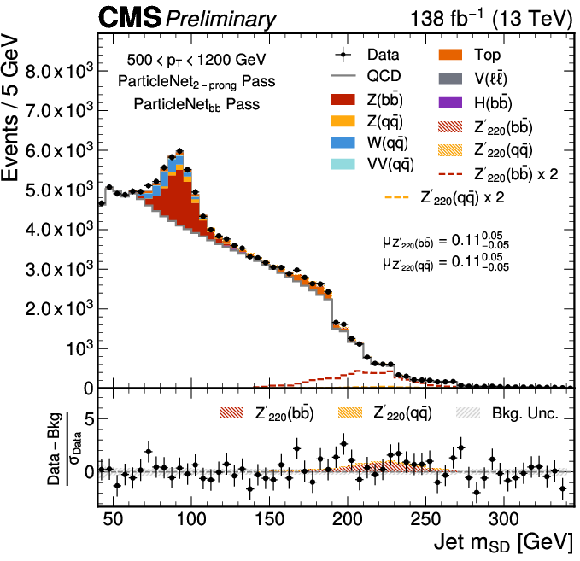
png pdf |
Figure 2-a:
The jet $ m_{\rm SD} $ distributions in the high-$ p_{\textrm{bvl}} $ (left) and low-$ p_{\textrm{bvl}} $ (right) signal regions, fitted with a signal-plus-background hypothesis corresponding to a Z' boson with a mass of $ m(\mathrm{Z}')= $ 220 GeV. The distributions are summed across all five $ p_{\mathrm{T}} $ bins and the four data-taking periods. The dashed lines represent the expected Z' signal yields for $ g_{\mathrm{q}}= $ 0.25 multiplied by a factor of two for visibility, while the fitted signal itself is shown as a hatched area. The lower panel shows the residual difference between the data and the overall background, divided by the statistical uncertainty in the data. |
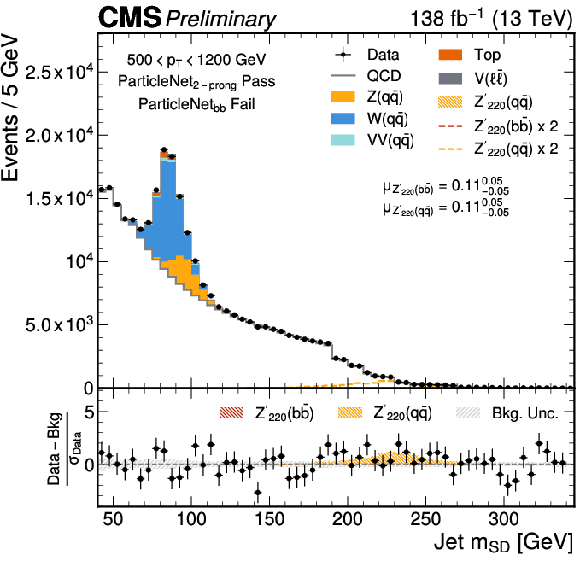
png pdf |
Figure 2-b:
The jet $ m_{\rm SD} $ distributions in the high-$ p_{\textrm{bvl}} $ (left) and low-$ p_{\textrm{bvl}} $ (right) signal regions, fitted with a signal-plus-background hypothesis corresponding to a Z' boson with a mass of $ m(\mathrm{Z}')= $ 220 GeV. The distributions are summed across all five $ p_{\mathrm{T}} $ bins and the four data-taking periods. The dashed lines represent the expected Z' signal yields for $ g_{\mathrm{q}}= $ 0.25 multiplied by a factor of two for visibility, while the fitted signal itself is shown as a hatched area. The lower panel shows the residual difference between the data and the overall background, divided by the statistical uncertainty in the data. |
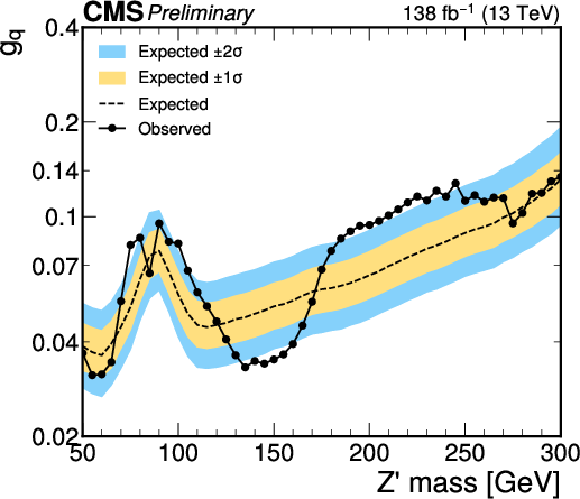
png pdf |
Figure 3:
Upper limits at 95% CL on the coupling $ g_{\mathrm{q}} $ between the Z' boson and quarks. The Z' boson is assumed to couple equally to quarks of all flavors, and to decay to quark-antiquark pairs with 100% branching fraction. The solid line represents the observed limits, while the dashed line and the green and yellow bands represent the expected limits and its variation at the one and two standard deviation levels. |

png pdf |
Figure 4:
Upper limits at 95% CL on the coupling parameters $ g_{\mathrm{q}\phi} $ (left) and $ g_{\mathrm{q}\mathrm{A}} $ (right). The $ \phi $ or A bosons couple to quarks with a coupling given by $ g_{\mathrm{q}\phi} $ or $ g_{\mathrm{q}\mathrm{A}} $ times the SM Yukawa couplings, respectively, and decay dominantly to bottom quark-antiquark pairs. The solid line represents the observed limits, while the dashed line and the green and yellow bands represent the expected limits and its variation at the one and two standard deviation levels. |
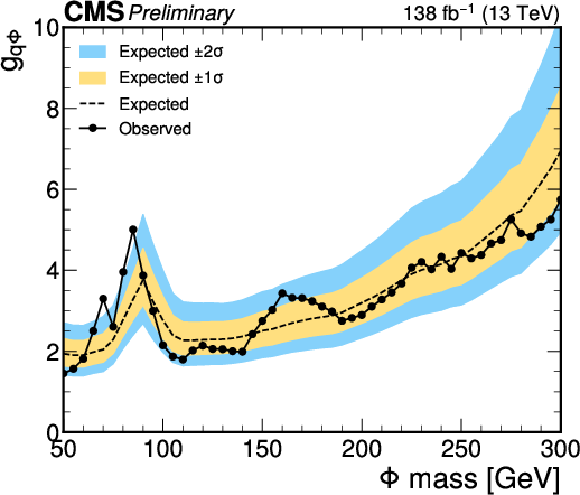
png pdf |
Figure 4-a:
Upper limits at 95% CL on the coupling parameters $ g_{\mathrm{q}\phi} $ (left) and $ g_{\mathrm{q}\mathrm{A}} $ (right). The $ \phi $ or A bosons couple to quarks with a coupling given by $ g_{\mathrm{q}\phi} $ or $ g_{\mathrm{q}\mathrm{A}} $ times the SM Yukawa couplings, respectively, and decay dominantly to bottom quark-antiquark pairs. The solid line represents the observed limits, while the dashed line and the green and yellow bands represent the expected limits and its variation at the one and two standard deviation levels. |

png pdf |
Figure 4-b:
Upper limits at 95% CL on the coupling parameters $ g_{\mathrm{q}\phi} $ (left) and $ g_{\mathrm{q}\mathrm{A}} $ (right). The $ \phi $ or A bosons couple to quarks with a coupling given by $ g_{\mathrm{q}\phi} $ or $ g_{\mathrm{q}\mathrm{A}} $ times the SM Yukawa couplings, respectively, and decay dominantly to bottom quark-antiquark pairs. The solid line represents the observed limits, while the dashed line and the green and yellow bands represent the expected limits and its variation at the one and two standard deviation levels. |
| Tables | |

png pdf |
Table 1:
Summary of scale factors extracted from the $ \mathrm{W}(\mathrm{q}\overline{\mathrm{q}}') $ control region. The $ f_{\textrm{2-prong}} $ parameter corrects the efficiency of the 2-prong tagger requirement, $ \delta_m $ corrects the $ m_{\rm SD} $ scale, and $ \delta_{\sigma} $ corrects the $ m_{\rm SD} $ resolution. Separate scale factors are derived for each data-taking period. |

png pdf |
Table 2:
Summary of transfer factor orders $ TF_{MC} $ and $ TF_{res} $ in order ($ p_{\mathrm{T}} $, $ \rho $) per year. $ TF_{MC} $ is derived with QCD MC dataset, while $ TF_{res} $ is derived with data. |
| Summary |
| A search for new dijet resonances with masses from 50-300 GeV has been presented. The search targets spin-1 resonances decaying equally to quark-antiquark pairs of all flavors and spin-0 resonances decaying to bottom quark-antiquark pairs. To circumvent trigger bandwidth limitations, the resonances are required to be produced with significant initial state radiation, and, thus, have large transverse momentum. Because of the large transverse momentum, the resonances are reconstructed as single large-radius jets with 2-pronged substructure. The resonances are distinguished from the backgrounds using the ParticleNet algorithm and identified as narrow peaks in the jet soft-drop mass spectra. No significant excesses above the standard model expectations are observed, and limits are set on the couplings of the resonances to quarks, assuming that the resonances decay only to quarks. For spin-1 resonances coupling equally to all quark flavors, the upper limits on $ g_{\mathrm{q}} $ range from 0.04-0.15. For spin-0 resonances coupling dominantly to bottom quarks, the upper limits on $ g_{\mathrm{q}\phi} $ ($ g_{\mathrm{q}\mathrm{A}} $) range from 1.5-5.8 (1.0-3.8). These are the most sensitive limits to date on dijet resonances with masses from 50-300 GeV. |
| References | ||||
| 1 | E. Eichten, I. Hinchliffe, K. D. Lane, and C. Quigg | Super collider physics | Rev. Mod. Phys. 56 (1984) 579 | |
| 2 | R. N. Mohapatra | Left-right symmetry, grand unification and cosmology | Progress of Physics 31 (1983) | |
| 3 | L. Randall and R. Sundrum | An alternative to compactification | PRL 83 (1999) 4690 | hep-th/9906064 |
| 4 | D. Abercrombie et al. | Dark matter benchmark models for early LHC Run-2 searches: Report of the ATLAS/CMS Dark Matter Forum | 1507.00966 | |
| 5 | A. Boveia et al. | Recommendations on presenting LHC searches for missing transverse energy signals using simplified $ s $-channel models of dark matter | Phys. Dark Univ. 27 (2020) 100365 | 1603.04156 |
| 6 | CMS Collaboration | Dark sector searches with the CMS experiment | Submitted to Phys. Rep, 2024 | CMS-EXO-23-005 2405.13778 |
| 7 | R. M. Harris and K. Kousouris | Searches for Dijet Resonances at Hadron Colliders | Int. J. Mod. Phys. A 26 (2011) 5005 | 1110.5302 |
| 8 | UA1 Collaboration | Two-jet mass distributions at the CERN proton-antiproton collider | PLB 209 (1988) 127 | |
| 9 | UA2 Collaboration | A search for new intermediate vector mesons and excited quarks decaying to two jets at the CERN $ \overline{\mathrm{p}}\mathrm{p} $ collider | NPB 400 (1993) 3 | |
| 10 | CDF Collaboration | Search for new particles decaying into dijets in proton-antiproton collisions at $ \sqrt{s} = $ 1.96 TeV | PRD 79 (2009) 112002 | 0812.4036 |
| 11 | D0 Collaboration | Search for new particles in the two-jet decay channel with the D0 detector | PRD 69 (2004) 111101 | hep-ex/0308033 |
| 12 | ATLAS Collaboration | Search for new resonances in mass distributions of jet pairs using 139 fb$ ^{-1} $ of $ pp $ collisions at $ \sqrt{s}= $ 13 TeV with the ATLAS detector | JHEP 03 (2020) 145 | 1910.08447 |
| 13 | ATLAS Collaboration | Search for light resonances decaying to boosted quark pairs and produced in association with a photon or a jet in proton-proton collisions at $ \sqrt{s}= $ 13 TeV with the ATLAS detector | PLB 788 (2019) 316 | 1801.08769 |
| 14 | ATLAS Collaboration | Search for resonances in the mass distribution of jet pairs with one or two jets identified as $ b $-jets in proton-proton collisions at $ \sqrt{s}= $ 13 TeV with the ATLAS detector | PRD 98 (2018) 032016 | 1805.09299 |
| 15 | CMS Collaboration | Search for high mass dijet resonances with a new background prediction method in proton-proton collisions at $ \sqrt{s} = $ 13 TeV | JHEP 05 (2020) 033 | CMS-EXO-19-012 1911.03947 |
| 16 | CMS Collaboration | Search for low mass vector resonances decaying into quark-antiquark pairs in proton-proton collisions at $ \sqrt{s}= $ 13 TeV | PRD 100 (2019) 112007 | CMS-EXO-18-012 1909.04114 |
| 17 | CMS Collaboration | Search for narrow resonances in the b-tagged dijet mass spectrum in proton-proton collisions at $ \sqrt{s}= $ 13 TeV | PRD 108 (2023) 012009 | CMS-EXO-20-008 2205.01835 |
| 18 | G. D'Ambrosio, G. F. Giudice, G. Isidori, and A. Strumia | Minimal flavor violation: An Effective field theory approach | NPB 645 (2002) 155 | hep-ph/0207036 |
| 19 | H. Qu and L. Gouskos | ParticleNet: Jet Tagging via Particle Clouds | PRD 101 (2020) 056019 | 1902.08570 |
| 20 | I. Moult, L. Necib, and J. Thaler | New Angles on Energy Correlation Functions | JHEP 12 (2016) 153 | 1609.07483 |
| 21 | CMS Collaboration | The CMS experiment at the CERN LHC | JINST 3 (2008) S08004 | |
| 22 | CMS Collaboration | Development of the CMS detector for the CERN LHC Run 3 | JINST 19 (2024) P05064 | CMS-PRF-21-001 2309.05466 |
| 23 | CMS Collaboration | Performance of the CMS Level-1 trigger in proton-proton collisions at $ \sqrt{s} = $ 13 TeV | JINST 15 (2020) P10017 | CMS-TRG-17-001 2006.10165 |
| 24 | CMS Collaboration | The CMS trigger system | JINST 12 (2017) P01020 | CMS-TRG-12-001 1609.02366 |
| 25 | GEANT4 Collaboration | GEANT 4---a simulation toolkit | NIM A 506 (2003) 250 | |
| 26 | CMS Collaboration | Extraction and validation of a new set of CMS PYTHIA 8 tunes from underlying-event measurements | EPJC 80 (2020) 4 | CMS-GEN-17-001 1903.12179 |
| 27 | J. Alwall et al. | Comparative study of various algorithms for the merging of parton showers and matrix elements in hadronic collisions | EPJC 53 (2007) 473 | 0706.2569 |
| 28 | R. Frederix and S. Frixione | Merging meets matching in MC@NLO | JHEP 12 (2012) 061 | 1209.6215 |
| 29 | J. Alwall et al. | The automated computation of tree-level and next-to-leading order differential cross sections, and their matching to parton shower simulations | JHEP 07 (2014) 079 | 1405.0301 |
| 30 | P. Artoisenet, R. Frederix, O. Mattelaer, and R. Rietkerk | Automatic spin-entangled decays of heavy resonances in Monte Carlo simulations | JHEP 03 (2013) 015 | 1212.3460 |
| 31 | S. Kallweit et al. | NLO electroweak automation and precise predictions for W+multijet production at the LHC | JHEP 04 (2015) 012 | 1412.5157 |
| 32 | S. Kallweit et al. | NLO QCD+EW predictions for V+jets including off-shell vector-boson decays and multijet merging | JHEP 04 (2016) 021 | 1511.08692 |
| 33 | S. Kallweit et al. | NLO QCD+EW automation and precise predictions for V+multijet production | in 50th Rencontres de Moriond on QCD and High Energy Interactions, 2015 | 1505.05704 |
| 34 | J. M. Lindert et al. | Precise predictions for $ V+ $ jets dark matter backgrounds | EPJC 77 (2017) 829 | 1705.04664 |
| 35 | P. F. Monni et al. | MiNNLO$ _{\text {PS}} $: a new method to match NNLO QCD to parton showers | JHEP 05 (2020) 143 | 1908.06987 |
| 36 | P. F. Monni, E. Re, and M. Wiesemann | MiNNLO$ _{\text {PS}} $: optimizing 2 $ \rightarrow $ 1 hadronic processes | EPJC 80 (2020) 1075 | 2006.04133 |
| 37 | T. Neumann | NLO Higgs+jet production at large transverse momenta including top quark mass effects | J. Phys. Commun. 2 (2018) 095017 | 1802.02981 |
| 38 | K. Becker et al. | Precise predictions for boosted Higgs production | SciPost Phys. Core 7 (2024) 001 | 2005.07762 |
| 39 | P. Nason and C. Oleari | NLO Higgs boson production via vector-boson fusion matched with shower in POWHEG | JHEP 02 (2010) 037 | 0911.5299 |
| 40 | G. Luisoni, P. Nason, C. Oleari, and F. Tramontano | $ \mathrm{H}\mathrm{W}^{\pm} $/$\mathrm{HZ}$+0 and 1 jet at NLO with the POWHEG box interfaced to GoSam and their merging within MiNLO | JHEP 10 (2013) 083 | 1306.2542 |
| 41 | H. B. Hartanto, B. Jager, L. Reina, and D. Wackeroth | Higgs boson production in association with top quarks in the POWHEG BOX | PRD 91 (2015) 094003 | 1501.04498 |
| 42 | S. Frixione, P. Nason, and C. Oleari | Matching NLO QCD computations with parton shower simulations: the POWHEG method | JHEP 11 (2007) 070 | 0709.2092 |
| 43 | S. Alioli, P. Nason, C. Oleari, and E. Re | A general framework for implementing NLO calculations in shower Monte Carlo programs: the POWHEG BOX | JHEP 06 (2010) 043 | 1002.2581 |
| 44 | S. Frixione, G. Ridolfi, and P. Nason | A positive-weight next-to-leading-order Monte Carlo for heavy flavour hadroproduction | JHEP 09 (2007) 126 | 0707.3088 |
| 45 | R. Frederix, E. Re, and P. Torrielli | Single-top $ t $-channel hadroproduction in the four-flavour scheme with POWHEG and aMC@NLO | JHEP 09 (2012) 130 | 1207.5391 |
| 46 | E. Re | Single-top $ \mathrm{W}\mathrm{t} $-channel production matched with parton showers using the POWHEG method | EPJC 71 (2011) 1547 | 1009.2450 |
| 47 | T. Sjöstrand et al. | An introduction to PYTHIA 8.2 | Comput. Phys. Commun. 191 (2015) 159 | 1410.3012 |
| 48 | J. M. Campbell and R. K. Ellis | MCFM for the Tevatron and the LHC | NP Proc. Suppl. 205-206 (2010) 10 | 1007.3492 |
| 49 | CMS Collaboration | Particle-flow reconstruction and global event description with the CMS detector | JINST 12 (2017) P10003 | CMS-PRF-14-001 1706.04965 |
| 50 | M. Cacciari, G. P. Salam, and G. Soyez | The anti-$ k_t $ jet clustering algorithm | JHEP 04 (2008) 063 | 0802.1189 |
| 51 | M. Cacciari, G. P. Salam, and G. Soyez | FastJet User Manual | EPJC 72 (2012) 1896 | 1111.6097 |
| 52 | D. Bertolini, P. Harris, M. Low, and N. Tran | Pileup Per Particle Identification | JHEP 10 (2014) 059 | 1407.6013 |
| 53 | A. J. Larkoski, S. Marzani, G. Soyez, and J. Thaler | Soft Drop | JHEP 05 (2014) 146 | 1402.2657 |
| 54 | D. Krohn, J. Thaler, and L.-T. Wang | Jet Trimming | JHEP 02 (2010) 084 | 0912.1342 |
| 55 | CMS Collaboration | Performance of electron reconstruction and selection with the CMS detector in proton-proton collisions at $ \sqrt{s}= $ 8 TeV | JINST 10 (2015) P06005 | CMS-EGM-13-001 1502.02701 |
| 56 | CMS Collaboration | Performance of the CMS muon detector and muon reconstruction with proton-proton collisions at $ \sqrt{s}= $ 13 TeV | JINST 13 (2018) P06015 | CMS-MUO-16-001 1804.04528 |
| 57 | CMS Collaboration | Performance of reconstruction and identification of $ \tau $ leptons decaying to hadrons and $ \nu_\tau $ in pp collisions at $ \sqrt{s}= $ 13 TeV | JINST 13 (2018) P10005 | CMS-TAU-16-003 1809.02816 |
| 58 | CMS Collaboration | Identification of hadronic tau lepton decays using a deep neural network | JINST 17 (2022) P07023 | CMS-TAU-20-001 2201.08458 |
| 59 | ATLAS Collaboration | Measurement of soft-drop jet observables in $ pp $ collisions with the ATLAS detector at $ \sqrt {s} $ =13 TeV | PRD 101 (2020) 052007 | 1912.09837 |
| 60 | M. Baak, S. Gadatsch, R. Harrington, and W. Verkerke | Interpolation between multi-dimensional histograms using a new non-linear moment morphing method | NIM A 771 (2015) 39 | 1410.7388 |
| 61 | S. Bernstein | Démonstration du théoreme de Weierstrass | Communications of the Kharkov Mathematical Society 13, 1912 | |
| 62 | R. A. Fisher | On the interpretation of $ \chi^{2} $ from contingency tables, and the calculation of P | J. R. Stat. Soc. 85 (1922) 87 | |
| 63 | CMS Collaboration | Performance of heavy-flavour jet identification in boosted topologies in proton-proton collisions at $ \sqrt{s} = $ 13 TeV | CMS Physics Analysis Summary, 2023 CMS-PAS-BTV-22-001 |
CMS-PAS-BTV-22-001 |
| 64 | CMS Collaboration | Precision luminosity measurement in proton-proton collisions at $ \sqrt{s} = $ 13 TeV in 2015 and 2016 at CMS | EPJC 81 (2021) 800 | CMS-LUM-17-003 2104.01927 |
| 65 | CMS Collaboration | CMS luminosity measurement for the 2017 data-taking period at $ \sqrt{s} = $ 13 TeV | CMS Physics Analysis Summary, 2018 link |
CMS-PAS-LUM-17-004 |
| 66 | CMS Collaboration | CMS luminosity measurement for the 2018 data-taking period at $ \sqrt{s} = $ 13 TeV | CMS Physics Analysis Summary, 2019 link |
CMS-PAS-LUM-18-002 |
| 67 | J. S. Conway | Incorporating Nuisance Parameters in Likelihoods for Multisource Spectra | PHYSTAT (2011) 115 | 1103.0354 |
| 68 | A. L. Read | Presentation of search results: The CL$ _{\text{s}} $ technique | JPG 28 (2002) 2693 | |
| 69 | T. Junk | Confidence level computation for combining searches with small statistics | NIM A 434 (1999) 435 | hep-ex/9902006 |
| 70 | G. Cowan, K. Cranmer, E. Gross, and O. Vitells | Asymptotic formulae for likelihood-based tests of new physics | EPJC 71 (2011) 1554 | 1007.1727 |

|
Compact Muon Solenoid LHC, CERN |

|

|

|

|

|

|